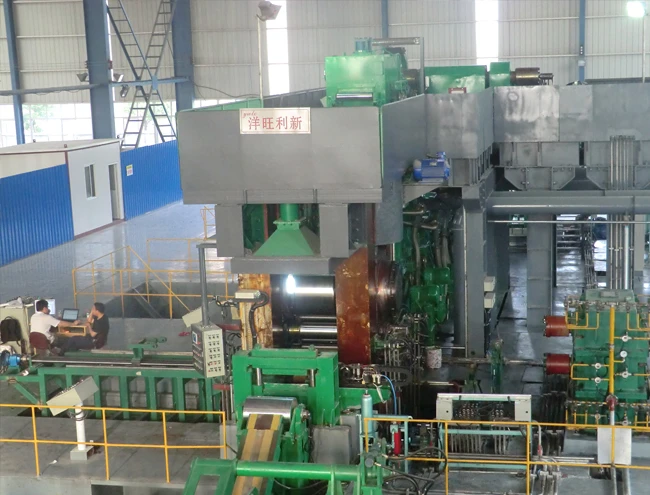
Cladding Rolling Mill - YWLX | Energy Efficiency High Yield
Introduction
The Cladding Rolling Mill developed by Beijing Yang Wang Li Xin Sci&Tech Co.,Ltd. (YWLX) represents a significant advancement in the production of bimetallic and triple-metallic strips. This innovative technology addresses the limitations of traditional methods such as hot roll bonding cladding and explosive cladding, offering improved surface quality, energy efficiency, and cost-effectiveness. This article explores the technical features, advantages, and applications of the YWLX Cladding Rolling Mill, supported by authoritative references from the National Institute of Standards and Technology (NIST).
Technical Features of the Cladding Rolling Mill
The YWLX Cladding Rolling Mill utilizes a cold rolling process to produce high-quality bimetallic and triple-metallic strips. This method eliminates the need for acid pickling treatments, resulting in a superior surface finish without oxide layers. The process is divided into three main stages: surface treatment before rolling, bonding rolling, and annealing treatment. This streamlined approach ensures a high yield rate of over 90%, significantly reducing production costs and investment requirements.

One of the standout features of the YWLX technology is its energy conservation and environmental protection. Unlike traditional methods that require reheating and acid pickling, the cold rolling process avoids these energy-intensive steps. This aligns with global initiatives to reduce carbon footprints and comply with environmental regulations. According to NIST, "Energy-efficient manufacturing processes are critical for sustainable industrial development" (NIST, 2023).
Advantages of YWLX Cladding Rolling Mill
The YWLX Cladding Rolling Mill offers several distinct advantages over conventional cladding technologies:
- Superior Surface Quality: The cold rolling process eliminates oxide layers, ensuring a clean surface without the need for acid pickling.
- High Yield Rate: With a yield rate exceeding 90%, the technology reduces material waste and production costs.
- Energy Efficiency: By eliminating reheating and acid pickling, the process significantly lowers energy consumption.
- Flexibility: The system can produce bimetallic and triple-metallic strips, including copper-steel, aluminum-steel, and stainless steel-steel combinations.
These advantages make the YWLX Cladding Rolling Mill an ideal solution for industries requiring high-performance materials, such as the electronic industry, chemical industry, and automotive sector.
Technical Specifications Table
| Parameter | Specification |
|---|---|
| Maximum Strip Width | 1000 mm |
| Minimum Thickness | 0.2 mm |
| Yield Rate | Over 90% |
| Process Stages | Surface Treatment, Bonding Rolling, Annealing |
| Supported Materials | Copper-Steel, Aluminum-Steel, Stainless Steel-Steel, etc. |
| Energy Consumption | Reduced by eliminating reheating and acid pickling |
Application Scenarios
The YWLX Cladding Rolling Mill is widely applicable across various industries:
- Electronics: High-conductivity copper-steel strips for heat sinks and connectors.
- Chemical Industry: Corrosion-resistant stainless steel-steel strips for reactors and pipelines.
- Automotive: Lightweight aluminum-steel composites for body panels and structural components.
- Construction: Durable cladding materials for decorative and functional applications.
These applications demonstrate the versatility of the YWLX technology in meeting the demands of modern manufacturing. As noted by NIST, "Advanced materials are essential for enhancing the performance and sustainability of industrial products" (NIST, 2023).
Company Background: Beijing Yang Wang Li Xin Sci&Tech Co.,Ltd.
Beijing Yang Wang Li Xin Sci&Tech Co.,Ltd. (YWLX) is a leading innovator in the field of roll bonding cladding technology. With a focus on research and development, the company has successfully developed a comprehensive system for cold rolling cladding, including equipment and processes. YWLX's commitment to innovation is evident in its ability to produce high-quality bimetallic and triple-metallic strips with precision and efficiency.
The company's expertise in hot roll bonding cladding and clad pipe welding has positioned it as a key player in the global market. YWLX's products are used in diverse applications, from industrial manufacturing to consumer electronics, reflecting its dedication to quality and customer satisfaction.

Conclusion
The YWLX Cladding Rolling Mill exemplifies the potential of cold rolling cladding technology to revolutionize the production of bimetallic and triple-metallic strips. By prioritizing energy efficiency, surface quality, and cost-effectiveness, YWLX addresses the challenges faced by traditional methods. As industries continue to demand sustainable and high-performance materials, the YWLX technology stands out as a reliable solution.
For more information about YWLX and its innovative products, visit the company's official website at https://www.bjywlx.com.
References
NIST. (2023). Energy-Efficient Manufacturing Practices. National Institute of Standards and Technology.
NIST. (2023). Advanced Materials for Industrial Applications. National Institute of Standards and Technology.
-
YWLX’s 1450mm Six-Hi Reversing Mill Goes Live in BangladeshNewsNov.24,2025
-
Adjusting Roll Gap in 6Hi Reversing Cold Rolling Mill for Thin StripNewsNov.13,2025
-
Quality Control Standards for Automatic Gauge Control in Strip RollingNewsNov.13,2025
-
Effect of Skin Pass Rolling on Metal DuctilityNewsNov.13,2025
-
Key Components of a Modern TempermillNewsNov.13,2025
-
Common Wear Patterns of Work Roll in Tandem Cold Mill OperationsNewsNov.13,2025
-
Revolutionary Skin Pass Rolling Technology for Enhanced Steel QualityNewsNov.04,2025










